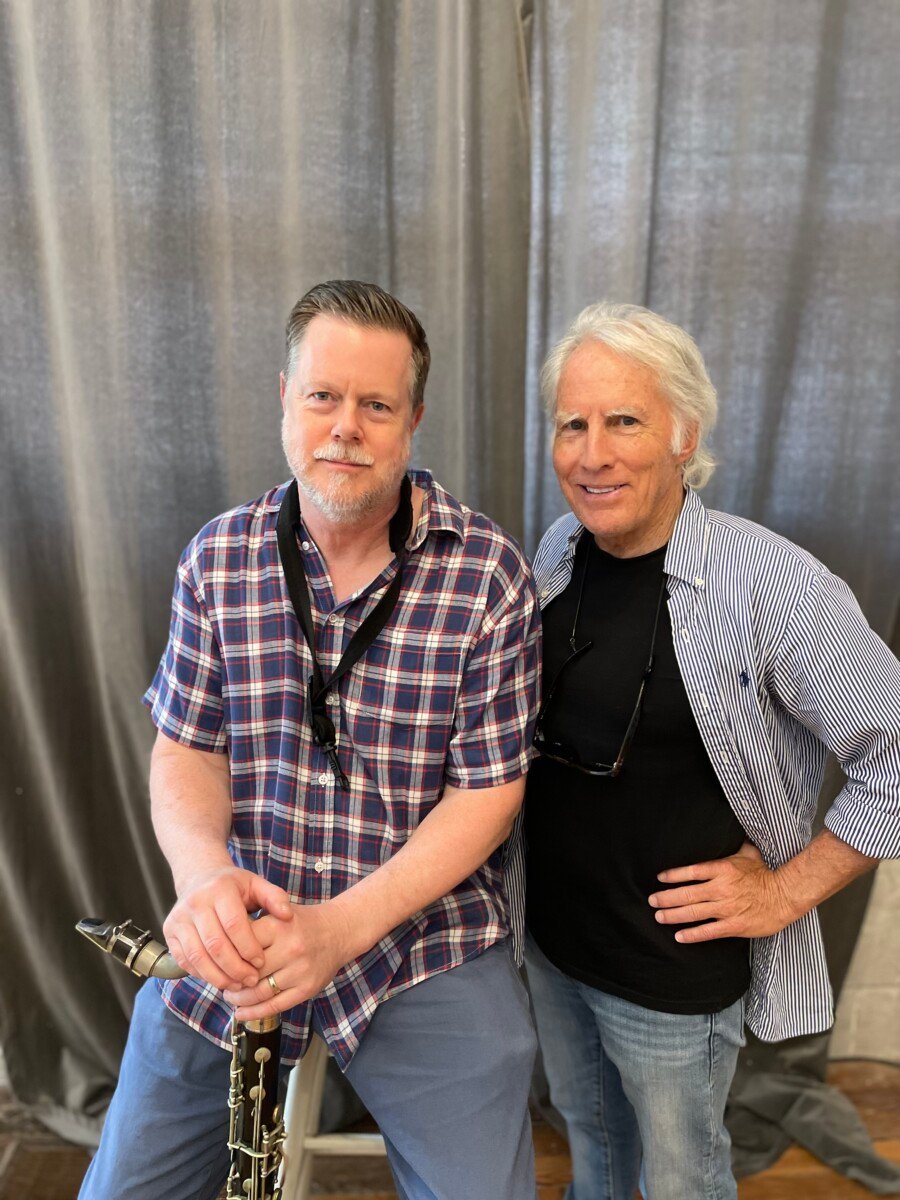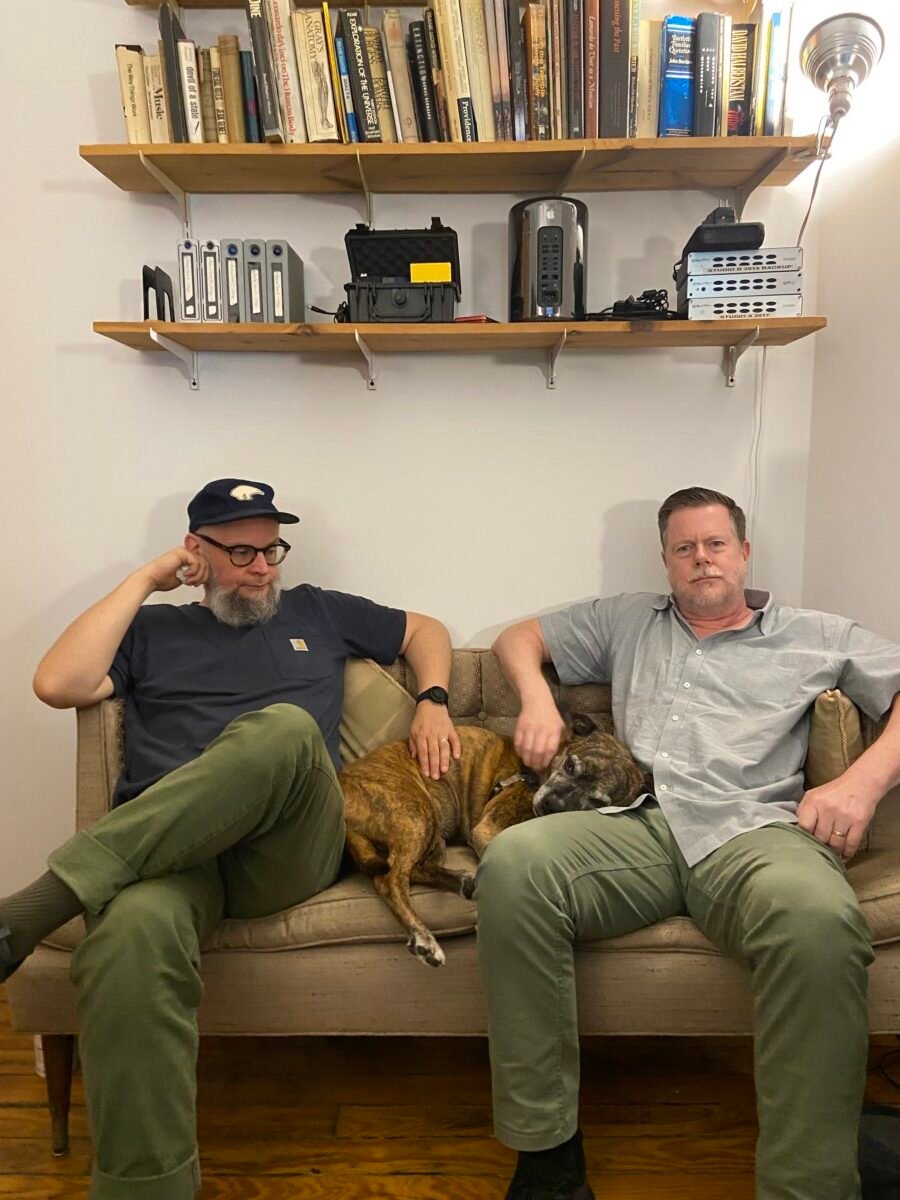Studio Work

[photo of Ken Vandermark and Chris Felver by John Corbett]
Two days were spent at Experimental Sound Studio in Chicago this week, each focusing on different aspects of documenting the creative process. On Wednesday, July 9th I recorded an interpretation of a composition by John Cage which Cage sent by fax to the photographer and filmmaker, Chris Felver, in October of 1991 (Felver’s films include “All the Notes”, a documentary about Cecil Taylor; chrisfelver.com). This performance of the material is meant to be used as part of a documentary about the artist that Felver is currently working on (as is a version, called “The Unquestioned Answers”, by Andrew Culver who was Cage’s assistant for the last 11 years of his life). The next day I went back to ESS with Nate Wooley to mix recordings by the trio we have with Paul Lytton, made by Christophe Albertijn on September 14th, 2024 at Paul’s painting and rehearsal studio near Sippenaeken, Belgium. The music is a rare document of Paul’s work with his electronics and “tabletop” percussion. Both sessions ran smoothly because of the assistance and expertise of recording engineer, Alex Inglizian.
Earlier this year, Chris Felver got in touch with me through the suggestion of poet/critic, John Yau, who I met when painter Richard Hull invited the two of us to help teach his “Words, Music, Action!” course at the Ox-Bow School of Art during the summer sessions of 2022 and 2024. Working with Richard and John was so exhilarating it led to a project that’s incorporated John’s poems with music I wrote for Edition Redux- the quartet with Erez Dessel, Lily Finnegan, and Beth McDonald- which was recorded last July and will include a visual art collaboration between John’s words and Richard’s images when it’s released.
The score Felver sent me was composed of two sets of 28 numbers, the first from 0 to 1800 and the second from 2 and ten, grouped in clusters of four. From what I understand about Cage’s work, the fax was notation for one of his time bracket compositions. The first set of numbers seemed to clearly indicate the start times for 28 “events” which began at 1:09 and concluded at 28:47. The second set of numbers suggested a set of 28 durations for events that ranged between 2 and 10 minutes. Since the numbers were grouped in fours, I thought of using one of the four instruments I play for a series of seven events. Inspired by Morton Feldman’s piece, “Five Pianos” (1972), I decided to record each of the four sets of events without listening to the others, so any implied causality was caused by chance.
To generate the material, seven 12-tone pitch sequences were randomly chosen by my folks and Ellen Major during a family visit to Boston in June. Four sets of seven were created by creating an inversion, retrograde, and retrograde inversion of the primary sequence. I chose to use the serial rows as a nod to Cage being a student and admirer of Arnold Schoenberg. For each minute contained in the duration of every time bracket twelve notes would occur, three within each 15 seconds. The speed, note duration, note register (high, medium, low), and dynamics were improvised; and each tone was to be articulated without slurs, vibrato (a nod to Feldman), and could be repeated and/or utilize octave leaps up or down before moving to the next pitch in the row, with the goal of avoiding harmonic implications of tonality by emphasizing “leading tones” or when using octaves.
Though I practiced the piece and its parameters for days to prepare for the recording session, being able to create four 30 minute sequences of variations on the clarinet, baritone sax, bass clarinet, and tenor, while striving to not repeat any of the phrasing throughout, was a real test of concentration and invention, which included utilizing material I’ve never worked with before.
Thankfully, Chris Felver was happy with the results. And I need to thank John Corbett, who was in attendance at the beginning of the session to be interviewed by Felver for the Cage documentary, for his recommendation to keep the rate of 12 notes per minute as I originally intended after all of us listened back to a test sample of the strategy for the music. Felver also interviewed me for the film. Hopefully, after recording a total of two hours of music, the answers I provided about Cage and his impact on me and art history were more coherent than they felt. One of Cage’s statements that I always consider is, “You can’t be an expert about what you don’t know.” Considering it when working with improvisation and experimentation as the center of what you do can be very liberating.

[photo of Nate Wooley, Dizzy, and Ken Vandermark by Alex Inglizian]
As mentioned, Nate Wooley, who had just completed an 8 concert tour in the States with Folk Music, his group with Chris Corsano and Ches Smith, joined me at ESS on Thursday, July 10th to help with the mixing process of the trio material we recorded with Paul Lytton last September. Despite being a live, remote recording, Christophe Albertijn did an incredible job with the original sound, making the task of mixing the three long-form improvisations with Alex Inglizian considerably easier. Paul’s playing with electronics and tabletop percussion is absolutely unique and an essential part of his decades of creative work. Touring with the gear is very difficult and prohibitive (In 2002, Paul shipped all of that equipment to the US for a tour we did that September with Paul Lovens. Something that would have been impossible without travelling with all the instruments in a van driven by friend and music curator from Slovenia, Bogdan Benigar. Link to the performance in Atlanta filmed by Scott Burland:
Following the session at Paul’s studio on September 14th of 2024 the trio went on tour, with concerts in Brugge, London (as part of Nate’s two-day residency at Café Oto, which included his tour de force performances of Elaine Radigue’s Occam X And Annea Lockwood’s Becoming Air), Geraardsbergen, and Haarlem. Thankfully, the concert in Haarlem was recorded with a multitrack setup. After a week of playing together the communication and musical synergy was in high gear, as is evident from the video footage of the concert at Pletterij:
The purely acoustic material with Paul on drum set/percussion has a relationship to, but also a very different character from, the electro-acoustic version of the trio’s music (in addition to Paul’s electronics, Nate uses an amplifier). Those recordings are now being mixed by Dave Zuchowski. The plan is for both sets of music to be released as a double CD in time for a tour in Europe during March of 2026. Much done, much still to do.